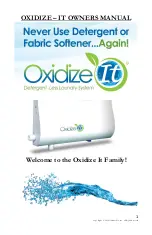
INSTALLATION & OPERATION MANUAL 14-0267 REV 0 (05/21)
PAGE
13
OF 20
ALTAIR II -
Electric Boilerless Convection Steamer
O
PERATION
Tips On Cooking Frozen Product
• Preheat cooking compartment.
• Break up frozen vegetables or product, if possible.
• If product is an ice block, set it in the pan on its narrowest side. This allows the steam to contact a greater surface area.
• Thawing is faster and better for the food in atmospheric steaming.
• Make sure frozen product is uniform in size to get best results.
• Season vegetables AFTER steaming.
• Less seasoning is required because steaming preserves natural flavors.
• When reheating prepared foods, stir occasionally to speed heating.
• Shallower pans will allow faster cooking times.
Blanching
Many foods can be blanched in atmospheric steam before being finished in ovens, fryers, or on grills and griddles. This
reduces total cooking time, helps ensure complete cooking and a moist product. Potatoes, poultry and seafood are
excellent examples. Blanching before frying reduces grease absorption by food products.
Tips On Pan Use
• For faster cook times, 2 1/2” deep perforated pans are recommended.
• It is not necessary and we do not recommend covering most pans of product. When cooking with only one pan, place
it in the center of the cooking chamber.
• Use solid pans where appropriate: scrambled eggs, rice, beans, dehydrated foods, prepared casseroles, sauces, cake or
other desserts (you can bake a cake in atmospheric steam), and when you want to prevent food from dripping on a lower pan.
• When cooking proteins (meat, poultry or seafood) use a solid catch pan under the perforated pan. Accumulated juices
can be used for soup stock, gravy or broth.
• Protein foods (meat, poultry or seafood) can be cooked in perforated or solid pans. If you are batch-cooking protein
foods use perforated pans and place a solid pan on the bottom rail. All the juices will then accumulate in this pan for
later use and to keep them out of the water reservoir.
• When atmospheric steaming, a pan cover can increase the cooking time up to 400%. Items such as frozen
casseroles, meat loaf, or sauces can be covered to avoid excess condensation.
• Root vegetables should be steamed in a perforated pan.
• Eggs can be hard cooked out of the shell and then chopped to avoid peeling shells.
• Always cook potatoes in perforated pans. This allows steam to circulate properly.
Other Helpful Hints
• Got a tough cleaning problem, pot, pan, utensil? Put it in your steamer to loosen burned-on food; it makes washing
much easier.
• Stale or frozen bread can be thawed or renewed in your steamer.
• Allow adequate spacing between pans for even steam circulation. Your pan rails and the shape of the steamer walls
are designed to maximize steam flow. Do not try to load more than the rack is designed for. Maximum capacity loads
cook best with perforated pans.
• Loosely packed pans will cook faster than tightly packed pans.
• To skin tomatoes, oranges etc. more easily, steam for a short time, then chill in cold water.
• When steaming pasta, shrimp, or ground meat, nesting a perforated pan in a solid pan works well. Lift out the
perforated pan to drain.
• Never have the water high enough or a pan low enough to touch water. Allow enough space for steam circulation.
Steam has 6 times more energy than boiling water – use the steam to cook.






































